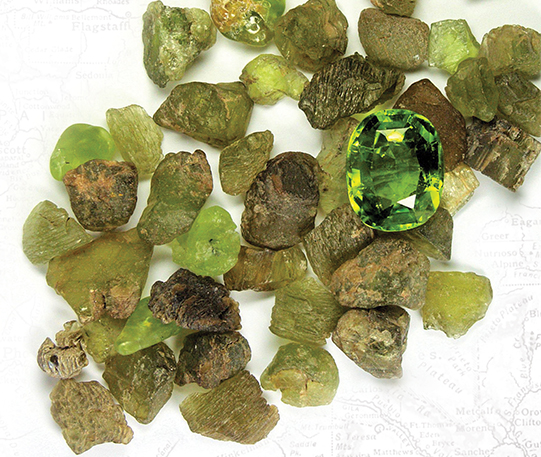
One of the richest and largest sources of peridot in the world is located in the heart of the San Carlos Apache tribal lands of Arizona, just a few miles east of Globe, Arizona. August’s birthstone, peridot is a rich green to the yellow-green color found in xenoliths of basaltic lava.
Olivine
Peridot is the gem form of olivine, but what is really odd is that olivine is not a mineral. If you read Fleischer’s Glossary of Mineral Species, olivine is not listed. This is because the name’s general use is given to a solid solution series of two minerals, fayalite and forsterite.
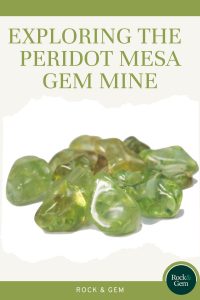
Pure forsterite is magnesium silicate, and fayalite is an iron silicate, but they rarely occur in pure form. This state is because magnesium and iron are present in varying amounts in both species. Whichever of these two elements dominates in a mineral determines if it is forsterite with magnesium exceeding iron or fayalite, the iron-rich species.
Olivine is the name assigned to this series, and if the mineral is gemmy, its identity is peridot. In the early days, the gem was known as topazos as it looks like yellow topaz. Another name for peridot is chrysolite, which means gold stone. No matter which name is applied, the stone’s color is always some green shade, which is influenced by traces of chromium or nickel. Peridot is one of the few gems found in only one color. True, peridot can range from bright yellow-green and low in iron to brownish-green and high in iron, so olivine is always green.
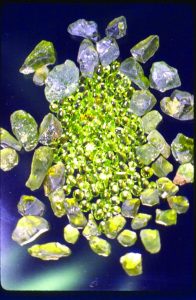
Evolution of Peridot Mining
Historically, the finest peridot gems were mined by the Egyptians on an Island in the Red Sea. In those early days, the green gems were easily mistaken for emeralds.
The Egyptians considered it the Gem of the Sun, and it is now the National Gem of Egypt. The Egyptians mined peridot at least 3,500 years ago on El Zabaragad Island, which in modern times is called St. John’s Island. The mining area was referred to as Peridot Hill.
The Egyptians also mined emeralds in the Littoral Zone area, the area between the Red Sea and the Nile River. Since the Egyptians lacked the skill to distinguish between two green stones from these two sources, some of Cleopatra’s emeralds could well be peridot gems. This confusion certainly existed with green gems in Europe, where ancient religious artifacts holding green gems from Egypt were all considered emeralds for centuries but are now proven in some cases to be Egyptian peridot.
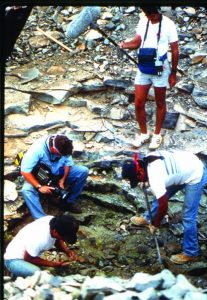
It is interesting to note that at some time, perhaps during the Dark Ages, the location of Zabaragad Island was lost and was only known through legends. Finally, in 1905, the island was rediscovered, and its peridot mines were once again opened.
San Carlos, Arizona
Today, the San Carlos, Arizona, peridot deposits supply most of the commercially sold and used peridot. Tribal members mine the peridot, which occurs as small green grains in the basalt. The entire volcanic structure called Peridot Mesa is mined exclusively by local residents. Peridot does occur elsewhere in Arizona, but the San Carlos Apache Indian Reservation is the leading source for peridot sold as rough and finished gems worldwide.
The work is not easy, as it has to be done by hand in order to break up the hard basalt where the peridot occurs. The workers use large hammers, sedges, chisels, and wedges to split and break up the solid rock and expose gas cavities filled with crystalline grains of peridot. The green grains often spill out of the opened pockets and are placed in buckets to be carried away for later sorting, washing, and preparing for sale.
Visiting Peridot Mesa
Peridot Mesa’s geology is typically volcanic, mainly basalt volcanic rock low in silica and high in magnesium with some iron, which is important for the formation of forsterite. The mineral also appears in volcanic bombs, large masses of molten lava ejected during an eruption that shoots into the air. These “bombs” cool as they fall to earth, taking on a recognizable twisted elongate egg shape in which peridot is sometimes found.
The green grains from Peridot Mesa are never as large as those found in Egypt and elsewhere. The area’s cut stones are most often in the one- to three-carat range, with a five-carat stone an exception. The Smithsonian boasts a cut green gem from the Peridot Mesa that weighs 35 carats, an amazing size for the region. This gem ranks as one of the best from Peridot Mesa.
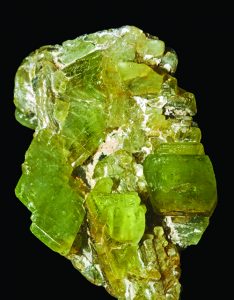
Peridot Characteristics
Peridot is a remarkable gem. It forms in the orthorhombic crystal system with a hardness between 6.5 and 7 and has poor cleavage, which means it can be faceted. It has a vitreous luster, and because of its rarity, fine color, and relatively small size as a gem, peridot is considered a precious gem.
If we could reach the earth’s upper mantle beneath our granitic crust, we would find huge quantities of olivine rock. Scientists, using earthquake vibrations and artificially induced earthquakes of the earth, show the upper mantle is made up mainly of olivine, likely mostly peridot. This prompts scientists to estimate that olivine is the most common rock on the earth. Just imagine the size of some gemmy peridot masses in the earth’s mantle. The mineral lends its name to an important mantle rock, peridotite, the rock where diamonds are found. These gems in peridotite originate in the lower mantle and are brought to the crust by volcanic action.
Peridot Above Ground
Above ground, olivine forms in many places on earth in limited amounts. The famous black sands of Hawaii are well mixed with tiny green grains of peridot. None of the grains are large enough to facet, but this is evidence of how common such granular peridot can be. And while we have many places where olivine and peridot have been found in limited amounts, it may surprise you to know peridot is also found in space, and it’s gemmy!
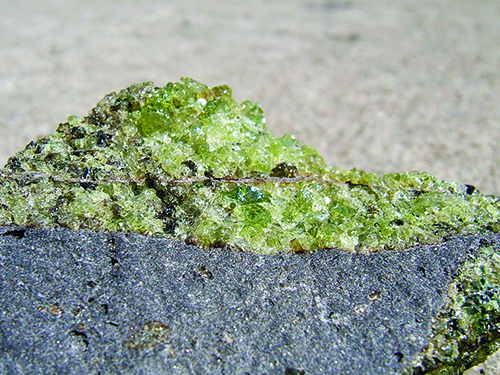
Peridot in Space
The earth sometimes is an audience to a comet that zooms into our solar system, curves around the sun, and heads back out into space. The solar wind causes these comets to develop long, sweeping tails that grow as the comet nears the sun. Scientific studies of these comets reveal the tails contain traces of peridot. Stony meteorites are another space rock with ties to peridot. Stony meteorites come in two general forms, carbonaceous chondrites and pallasites. Chondrites look like ordinary earthly stones and are eagerly sought by astronomers as they represent some of the more primitive meteorites to have formed. They contain organic compounds, which are very suggestive of life, and as such are studied carefully.
Some years ago, a carbonaceous chondrite broke into a thousand pieces and fell near Allende, Mexico. Arizona astronomers were particularly anxious to obtain pieces of this meteorite. Because it had landed so close to Arizona, serious efforts were made to collect it. Chuck Lewis, curator of Arizona State University’s meteorite collection, was lucky to be invited to help retrieve boxes of this important meteorite. The University boasts one of the great meteorite collections.
Pallasites
Pallasites are of interest here because they contain large grains of peridot olivine like the mantle. The peridot is locked in solid nickel-iron material suggestive of the earth’s lower mantle-nickel-ion core. The olivine in pallasites is mostly gemmy, transparent peridot. Some brave soul even removed the large grains of peridot from a fallen pallasite and faceted tiny peridot gems from it.
Arizona’s Peridot Mesa will continue to produce for years to come. Lucky is the gem collector who can own a green gem from here that weighs in at over three carats. It is a real precious treasure.
This story about peridot previously appeared in Rock & Gem magazine. Click here to subscribe! Story by Bob Jones.














